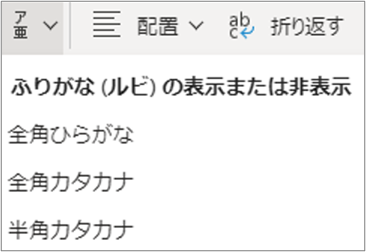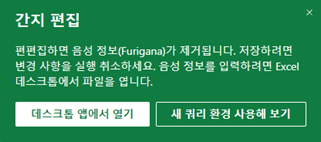Note: The content in this topic is only applicable to Far East languages. To use furigana, set your region to Japanese, Chinese, or Korean. For more information, see Change regional format settings in Excel for the web.
In Excel, you can choose between three types of phonetic guides: full-width katakana, half-width katakana, and hiragana. You can change the font style, font size, and alignment of phonetic guides. You can modify phonetic guides, and you can add phonetic guides to Japanese data that has been entered in a cell. The phonetic character string that was used to enter the Japanese data is used to apply phonetic guides. When you sort sheet data, Japanese data is sorted by its phonetic guides by default. If the correct phonetic guides have been used on characters that use them, Japanese terms are sorted in the same order as they would occur in a Japanese dictionary. If the phonetic guides are not entered correctly, make the necessary corrections.
When you display phonetic guides in the Japanese version of Excel and enter kanji (Chinese characters that are used in the Japanese language), Excel automatically adds the phonetic symbols to the guides.
Important: If you don't see Display phonetic characters to clarify pronunciation under Font on the Home tab, you must turn on Japanese language features. To learn more, see Change the language Office uses in its menus and proofing tools.
Do any of the following:
-
Select the cells that contain the phonetic guides whose font or type you want to change.
-
On the Home tab, under Font, click Display phonetic characters to clarify pronunication
-
Do any of the following:
|
To |
Do this |
|---|---|
|
Change the font |
Click the Font tab, and then in the Font box, click the font that you want. |
|
Change the font size |
Click the Font tab, and then in the Size box, click the font size that you want. |
|
Change the phonetic guide type |
Click the Setting tab, and then under Type, click the phonetic guide type that you want. |
Tip: You can apply formatting (such as bold or italic formatting), colors, underlining, or character effects to phonetic guides on the Font tab.
-
Select the cell that contains the text with the phonetic guides that you want to change.
-
On the Home tab, under Font, click Display phonetic characters to clarify pronunication
-
Double-click the cell that contains the phonetic guides that you want to modify, and then click the phonetic guides.
-
Modify the phonetic guides.
-
To confirm the modified phonetic guides, press RETURN twice.
To cancel the changes, press ESC twice.
Notes:
-
To use the keyboard to move the cursor to the phonetic guides, press OPTION + SHIFT + UP ARROW. To return to the parent string that the phonetic guides apply to, press OPTION + SHIFT + DOWN ARROW. The color of the parent character string changes while the phonetic guides are being modified.
-
If the displayed phonetic guides are incorrect, you can select the cell that shows the incorrect phonetic guides and change it by using the same method you use to enter a character string. On the Home tab, under Font, click Phonetic, and then click Edit.
-
The default alignment of phonetic guides is left alignment (that is, placed along the left edge of the kanji to which the phonetic guides apply). You can change the alignment to no alignment (all phonetic guides are combined and aligned along the left edge of the cell), center alignment (centered against the kanji to which the guides apply), or distributed alignment (set with equal spacing against both edges of the kanji to which the guides apply).
-
Select the cells that contain the phonetic guides whose alignment you want to change.
-
On the Home tab, under Font, click Display phonetic characters to clarify pronunication
-
On the Setting tab, under Alignment, click the alignment that you want to apply.
-
Select the cells that contain the phonetic guides that you want to show or hide.
-
On the Home tab, under Font, click Display phonetic characters to clarify pronunication
When phonetic guides are displayed, the check mark next to Show Phonetic Fields is visible. To hide phonetic guides, clear the check mark.
Note: Excel automatically adds phonetic symbols only to new data entered in the Japanese version of Excel. If you open files that were created in earlier versions of Excel or in other programs, phonetic symbols are not generated automatically.
First, make sure you change the editing language to Japanese. Then you can view the font style, font size, and alignment of furigana, a phonetic reading aid, in Excel Online for Japanese, Korean, Chinese and Hong-Kong languages and regions. You can even make minor changes to the text.
Note The Show/Hide command is available in all Far East languages, but the Type Change command is only available in Japanese.
Excel for the web region settings are managed by the host, such as SharePoint or OneDrive.
To view, change, and print furigana, Change your personal language and region settings.
Tip For more information about changing other regional settings, such as dates and currency, see Change regional format settings in Excel for the web.
-
To enable furigana, select a range of cells.
-
In the Font group of the Home tab, you can show or hide furigana and choose one of the three furigana types: hiragana, full-width katakana, and half-width katakana.
Hiragana
Full-width katakana
Half-width katakana
Notes
-
You can make some minor changes to the text, such as color and bolding, without removing the furigana. Other text changes may remove the furigana. If this happens, press CTRL+Z to undo the changes.
-
If the text is wrapped, or rich text or vertical text are used with furigana, you can view the furigana at the top of the cell, but without spaces (This is called the no-control version of furigana).
To edit furigana, you must use Excel for Windows. If there’s no furigana information in the cell, the Show/Hide command is disabled.
If you attempt to edit furigana in Excel Online, Excel displays the following message:
|
English |
|
|
Japanese |
|
|
Korean |
|
See also
Change the language Office uses in its menus and proofing tools

















